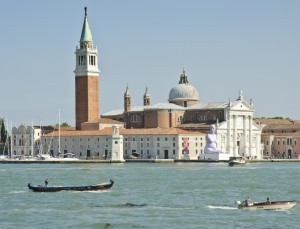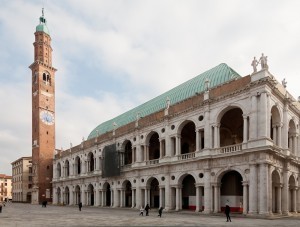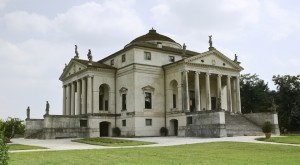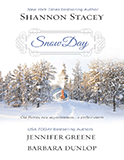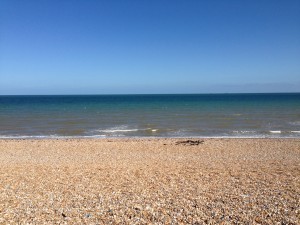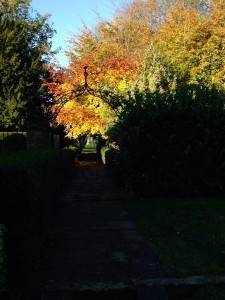Hannah Fielding's Blog, page 113
January 8, 2014
The most famous Venetian? Andrea Palladio
What is it, exactly, that so many people fall in love with when they visit Venice? What makes this historic city quite so romantic, so magical? The lagoon and canals play their part, of course, but inarguably at the core of the Venetian charm is its stunning architecture.
In The Echoes of Love, my heroine, Venetia, is an architect, having studied and qualified at university. British by birth, she could easily have chosen to remain in England to pursue her career, but it is Venice that called to her – where better for a young, imaginative, talented creative to be based than a city steeped in architectural wonder?
One man, more than any other, can be credited with many of the beautiful buildings in Venice. Andrea Palladio, in a sense, is to Venice what Gaudi is to Barcelona – and yet his legacy dates back much further – he lived from 1508 to 1580. The Venetians were incredibly lucky that Palladio called Venice home and chose to create all his works for the Republic of Venice, so that Palladio will always remain inextricably connected to the cityscape.
Though he was entirely Venice based, the architect wrote a guide to architecture that was widely celebrated, and today he is respected worldwide as the most influential Western architect in history.
Palladio was heavily influenced by the greats of architecture, the Romans and the Greeks, and he read widely across the arts, sciences and classical literature. He was in fact born Andrea Di Pietro della Gondola, but his mentor, the scholar Trissino, rechristened him Palladio after Pallas Athene, the Greek goddess of wisdom – Palladio means ‘wise one’.
As Palladio grew into his vocation as architect, he developed a very particular style now known as the Palladian style. He built palaces, churches and, most of all, villas, using simple materials like brick rendered with stucco and classical proportions. Goethe called Palladio a genius, the British architect Sir Christopher Wren followed his style, and Thomas Jefferson was so taken with the Palladian style that the design of the United States Capitol building was heavily influenced by the Italian architect.
Here are just three examples of Palladio’s buildings in the Republic of Venice.
Church of San Giorgio Maggiore, San Giorgio Maggiore island, Venice
The Basilica Palladiana, Vicenza
Villa La Rotonda, Vicenza
January 5, 2014
The Regatta delle Beganne
 On 6 January, as part of the celebrations for their Epiphany Festival, Venetian will line the paths alongside the Grand Canal to watch a boat race with a difference: the Regatta del Beganne (Witches’ Race).
On 6 January, as part of the celebrations for their Epiphany Festival, Venetian will line the paths alongside the Grand Canal to watch a boat race with a difference: the Regatta del Beganne (Witches’ Race).
The Regatta del Beganne began back in the late 1970s as something of a joke between two friend who decided to race each other in mascaretas (traditional boats powered by one oar only) while dressed as witches. All these years later, the event has grown to become one of the most fun of the Venetian festival calendar, organised by a historical rowing club, Cannotieri Bucintoro, and promising to launch the year’s regattas with a smile and a cheer.
Competitors – a handful of over-50s men, all in witch costumes – race along the Grand Canal from San Toma to the Rialto Bridge. It’s something of a challenge in the mascaretas, which lack the bend of the classic gondola and so require a backward stroke after each forward one to keep on course.
At the finish line the winner is awarded mulled wine, sweets and a flag, and he arrives to a chorus of classic Venetian songs, like the following:
La Befana comes at night
With her shoes all tattered and torn
She comes dressed in the Roman way
Long live La Befana!
The huge stocking that was hung on the Rialto Bridge is taken down and its contents – sweets – handed out to children in the crowd.
Here’s a glimpse of last year’s race:
So what is the inspiration for this fun race? It comes down to the Befana – a witch, so legend tells, who brings gifts to children on Epiphany: sweets and toys for good ones, and coal for bad ones (much like Santa – children even leave stockings out on the eve of the 6th). Befana may be ugly, but she’s benignly so. She’s jolly and colourful and kind enough, apparently, to sweep up your home when she visits with the children’s gifts – so long as you leave her an offering of a glass of wine!
January 4, 2014
A brief history of tiramisu
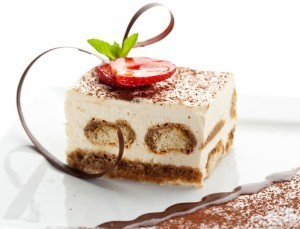 No doubt you’re very familiar with this coffee-flavoured dessert, which features on countless restaurant menus worldwide. You probably also know that, like zabaglione and gelato, the sweet is Italian in origin. But did you know that tiramisu is from the environs of Venice?
No doubt you’re very familiar with this coffee-flavoured dessert, which features on countless restaurant menus worldwide. You probably also know that, like zabaglione and gelato, the sweet is Italian in origin. But did you know that tiramisu is from the environs of Venice?
There is some dispute over who exactly came up with the desert. Some say it was head chef Carminantonio Iannaccone in Via Sottotreviso in 1969; some say it was chef Ada Campeol of the restaurant Alle Beccherie; some say it was baker Roberto Linguanotto and apprentice Francesca Valori two years earlier. But what is certain is that tiramisu was first created in Treviso, a city in Veneto, near Venice.
The literal translation of tiramisu is ‘pick me up’. Ada Campeol said that she invented the recipe when she was looking for instant energy while she breastfed her first child, hence the calorific ingredients: ladyfingers (known as Savoiardi in Italy) soaked in espresso and then layered in a dish with a sweet and delicious mixture of eggs, sugar and mascarpone cheese, dusted with fine cocoa powder.
The Italians first took the recipe to heart, and hundreds of adaptations appeared, and then it was taken on worldwide. Today, there is even a World Tiramisu Day, on 17 January, when cooks across the globe compete to make the best version of the dessert as part of the International Day of Italian Cuisine.
So many recipes exist for tiramisu; I’ve put together some of my favourites for you:
Tiramisu Gateau and Low-Fat Tiramisu (Delicious Magazine)
Irish Cream Tiramisu (Nigella Lawson)
Italian Summer Strawberry ‘Tiramisu’ (Aldo Zilli)
Simple Tiramisu (Organic Tuscany Cookbook)
Easy Tiramisu Brownie Bars (Betty Crocker)
Tiramisu Ice-cream Cake (BBC Good Food)
Enjoy!
January 3, 2014
Book review: Snow Day: Heart of the Storm/Seeing Red/Land’s End by Shannon Stacey, Jennifer Greene and Barbara Dunlop
From the blurb:
Tucker’s Point three-day forecast: stormy with a chance of romance.
HEART OF THE STORM by Shannon Stacey
Brody Rollins is back in tiny Tucker’s Point, Maine, for the first time in five years, and now he can’t escape…from former neighbours, old regrets or maddening glimpses of his ex-fiancée.
SEEING RED by Jennifer Greene
Stranded at her grandfather’s seaside cottage, Whitney Carr prepares to face the blizzard alone. But unexpected help soon arrives—in the form of her secret high-school crush.
LAND’S END by Barbara Dunlop
Tessa Ambroise is desperate to ditch the charming, infuriating hotelier circling her late aunt’s century home like a vulture. But the snow piling up outside the mansion puts both their plans on hold.
When a child goes missing, this perfect storm of cramped quarters and freezing temperatures brings old flames and new acquaintances closer together…but will they go separate ways once the sky clears?
I thoroughly enjoyed this Harlequin compilation book. The stories are just long enough to be satisfyingly developed, but just short enough to read in one or two sittings (depending on your reading speed).
Usually, in a compilation like this I engage with one or two out of the three stories, but in this book I was pleasantly surprised to find I connected to all the stories and characters. I love the fact that in each the characters share a past together and have ‘unfinished business’ and a lingering attraction which they must decide to either ignore or allow to change them. The intense, dangerous circumstances created by the ice storm beautifully throws together the couples, forcing them to confront realties and feelings long buried, and I love the juxtaposition of the biting cold outside and the fiery passion inside!
My favourite aspect of the books is how they interconnect – how a seemingly minor element of one book becomes a major plot point in another. It makes for very satisfying reading indeed. I also liked the storyline about the missing child, and how the emotion this creates in the community acts a catalyst for emotion rising within the characters.
Overall, a super Harlequin read – perfect for dipping into over the winter while curled up someplace warm, and guaranteed to leave you with a lovely warm, fuzzy glow.
I was offered this book in exchange for a fair review via NetGalley.
Snow Day is available now from Amazon; click on the book cover below to visit the store.
January 2, 2014
Stripes of colour
December 31, 2013
‘Try before you fully buy’ – a new order in book ownership?
 I was born into a family that loved books. There were books in each room of our house – of all shapes, sizes, genres and authorships. During my childhood many people chose to leave my country due to the political situation there, and they would leave mountains of books in their wake. So my father would often come back from a second-hand shop staggering under the weight of a new boxful of books he’d picked up for a pittance. What a treasure trove!
I was born into a family that loved books. There were books in each room of our house – of all shapes, sizes, genres and authorships. During my childhood many people chose to leave my country due to the political situation there, and they would leave mountains of books in their wake. So my father would often come back from a second-hand shop staggering under the weight of a new boxful of books he’d picked up for a pittance. What a treasure trove!
For all of my life, then, I have been surrounded by books, largely due to the book-buying habit I built up. Until the evolution of the ereader and the ebook, that was how all readers lived: buy a book, read the book and either keep that book (most likely, for me) or pass it on, whether to a friend or to a charity shop; combined, of course, with membership at the local library.
But as they say, ‘the times they are a’changing’, thanks to ebooks. Some readers now shun all print books. Some shun all ebooks and stick to print only. The majority, I suspect, are like me and compromise: some ebooks, some print. And in that final category lies a new kind of book owner: the ‘try before you fully buy’ sort.
Here is the process, which is gaining ground rapidly among readers:
Buy an ebook version of a book.
If you really liked the book, go and buy it in paperback or hardback format, to keep on your bookshelf forevermore.
If you didn’t really like the book, either archive it on your ereader or delete it entirely.
The end result is a bookshelf whose contents represent only those books you really, really love and want to read again and recommend to others. Orderly and straightforward indeed.
There is also an argument that this new approach to book ownership is more frugal than the traditional approach of taking a gamble on print books. For example, say you buy 50 books per year, approximately one per week, and say that a paperback costs £8 and an ebook costs £4.
If you buy all your books in print then your yearly outgoing is £400. Guestimating that only around 10 per cent of those books (five) are long-term keepers, you’ve spent £80, in effect, on finding books to hold on to.
But if you buy all your books in ebook format initially, your yearly outgoing is £200. Then you go out and re-buy five of the books in print (£40). Total outlay is £240; cost per retained book is £48.
But enough of the bewildering maths (always a subject that sent me off into a romantic daydream in my school days). Though the logic of buying all books in ebook format first may be sound, to do so is to lose out on a whole world of enjoyment and symbolism. You miss out on
Browsing for hours in book shops, and queuing at the checkout with a new book or two, just for you, which gives you a warm glow in your stomach.
Rummaging among second-hand books in markets and back-street stores, and finding little gems for a song.
Receiving a book as a gift – something you’d never have chosen – and having the chance to broaden your horizons.
The smell, the sound, the feel of holding books in your hand.
The sense of risk, the thrill of taking a gamble on a new book. Doing so is an investment of faith, and there is something wonderfully exciting about sitting down to page through an unknown story. Yes, you may get to the end and feel the book wasn’t quite for you. But oh, you may get to the end and have loved, loved the book, and that object, that collection of printed pages bound together, will become an item you’ll treasure forever. Each time you pick it up you will remember the first read, the first experience. It becomes a little piece of you.
For me, then, while I’ll continue to read a mixture of print and ebooks, I don’t think I can ever become a follower of the ‘Try before you fully buy’ school. I need the magic. I need the connection.
How about you? I would love to hear your thoughts on the subject.
December 30, 2013
The very best of Venetian landscape paintings: Canaletto
Ask any art historian about famous Venetian artworks and the name ‘Canaletto’ will quickly crop up. Canaletto is commonly admired as one of the best painters of his time, and Venice was his chief inspiration.
Canaletto was born Giovanni Antonio Canal in Venice in 1697, the son of painter Bernardo Canal (the nickname Canaletto means ‘little Canal’). Following in his father’s footsteps, Canaletto trained under his father to paint scenery for plays, but he soon found himself keen to capture the myriad scenes of the city around him on canvas also.
He had a fresh, new style which pleased patrons and English tourists in the city – he’d paint both the mundane, daily life and also the grandeur of architecture and pageantry. Unusually for his time, Canaletto liked to paint in situ, overlooking the scene, rather than locked up in a studio, which is a key reason for the accuracy of his depictions. He was also celebrated for the natural light he brought to each scene.
Once he was established in Venice, Canaletto travelled to London, where his style and works inspired art collectors. He sold Venice scenes in England, but also painted some well-respected works of London landmarks, such as Westminster Bridge. King George III bought most of his collection.
Later in his life Canaletto’s popularity dwindled, but not so today: in 2005 an art collector paid £18.6 million for his painting ‘View of the Grand Canal from Palazzo Balbi to the Rialto’!
There is a wonderful slideshow of 132 Canaletto paintings on the BBC Arts website, which gives you a great overview of Venice in his time. The following video is also worth a look – it shows 15 of his Venetian paintings in a three-dimensional format.
December 28, 2013
The Venetian composer: Antonio Vivaldi
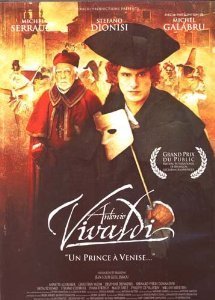 At the beginning of my new book The Echoes of Love, my heroine, Venetia, and hero, Paolo, are weaving their way through the crowds celebrating the Venice Carnival, and what better music to be stirring the revellers than that of Antonio Vivaldi?
At the beginning of my new book The Echoes of Love, my heroine, Venetia, and hero, Paolo, are weaving their way through the crowds celebrating the Venice Carnival, and what better music to be stirring the revellers than that of Antonio Vivaldi?
Vivaldi (1678–1741) was born and bred in Venice, and he grew up to become a composer and a violinist. To this day, he’s revered as one of greatest Baroque composers, and his works have been hugely influential in European culture and in the inspiration of musicians who followed in his footsteps.
Here are some little-known facts about the great composer:
He was known as il Prete Rosso (the Red Priest) for the vibrant shade of his hair!
He was ordained as a Catholic priest, but due to ill health he had very few duties in the Church.
For many years of his life Vivaldi worked as the ‘master of violin’ at the Republic-funded Ospedale della Pietà orphanage in Venice. The aims was to do more than shelter homeless children, but also to educate them. With that in mind, boys learned a trade but girls were members of the Ospedale orchestra and choir, which gained quite a reputation for its quality with Vivaldi at the helm. Many of Vivaldi’s works (more than 60, in fact) were thus written for girls at the home.
He wrote his most famous work, The Four Seasons, in Venice. It comprises four violin concertos, each conveying the mood of a single season.
Although today Vivaldi is a household name, and so was the case (in the houses of the cultured and rich, at least) in his time, the composer fell out of favour by the time of his death, and his renaissance as a celebrated musician only began in the 20th century.
To get a feel for Vivaldi, there is no better starting point than The Four Seasons. Here is a video covering the entire work:
The Allegro in ‘Spring’ is particularly popular for weddings, as is the following, ‘Concerto in D Major, Largo’, which is wonderfully lulling and romantic.
If you are interested in the life of Vivaldi, you may search out a copy of the 2005 film Antonio Vavaldi: Un Prinse a Venice. It was an Italian-French co-production, though, so you may struggle to find an English-language version. But if nothing else, the cover is wonderful – see the image with this post.
December 27, 2013
Destiny: Set in stone, or fluid?
When it comes to the subject of destiny for writers and philosophers and romantics, three schools of thought exist:
Destiny is an unswayable force. Virgil said, ‘Let us follow our destiny, ebb and flow. Whatever may happen, we master fortune by accepting it.’
Destiny is under our control. Emerson believed, ‘The only person you are destined to become is the person you decide to be.’ Shakespeare wrote, ‘It is not in the stars to hold our destiny but in ourselves.’
Destiny does not exist. ‘Destiny is but a phrase of the weak human heart – the dark apology for every error. The strong and virtuous admit no destiny…’ So wrote the 1st Baron Lytton.
The third holds no truth for me. All of my romance novels have some sense of destiny about them, because it’s mysterious, romantic and, to me, realistic. But to what degree a love story is pre-determined is an interesting question.
In my new book, The Echoes of Love, the hero Paolo quotes the following verse by Persian poet Omar Khayyám (1048–1131):
The Moving Finger writes; and, having writ,
Moves on: not all the Piety nor Wit
Shall lure it back to cancel half a Line,
Nor all thy Tears wash out a Word of it.
Paolo’s clarifies his point as follows: ‘Man is not free. Our lives are written for us.’ This is emblematic of the powerlessness Paolo feels in his own life. He is lost, a shadow of his former self, and before meeting Venetia he had no hope, not even the idea, that the future could be any different.
But along comes Venetia, who does not agree with Paolo’s limited and somewhat sad outlook on life, on love. She sees herself as having a measure of control over her destiny. ‘Fate is for those too weak to determine their own destiny,’ she tells Paolo. As a modern, independent woman who’s already had her heart broken through the loss of a man, how can she live her life in any other way than being in charge of her future, and thus able to protect her aching heart?
And yet, by the ending of the book readers can be in no doubt that destiny has played a big part in the love story – without wishing to give away a spoiler, the lovers have been brought together, despite the odds stacked against them.
The crux of the matter is best expressed through the wisdom of William Jennings Bryan: ‘Destiny is not a matter of chance; but a matter of choice. It is not a thing to be waited for, it is a thing to be achieved.’
I would add: If one has the courage to make the right choice.
Ultimately, Paolo and Venetia must make the right choice in the face of their destinies. Paolo must concede that he has some say in his destiny, and has the power and right to redefine his path. And Venetia must come to see that a certain amount of what’s wonderful in life is delivered serendipitously – she must choose to relinquish some control and to let love guide her. Only then, through empowered and informed choices, can love prevail.

